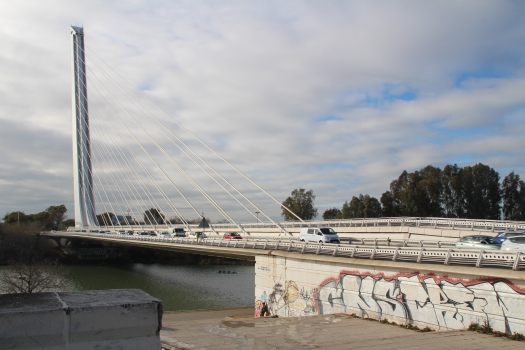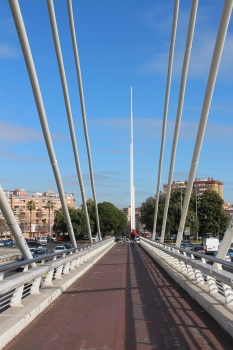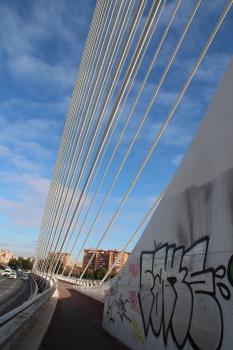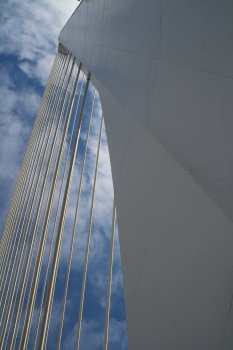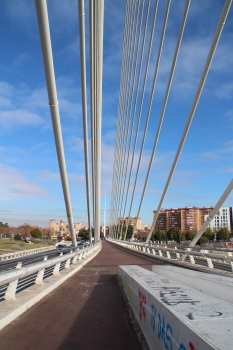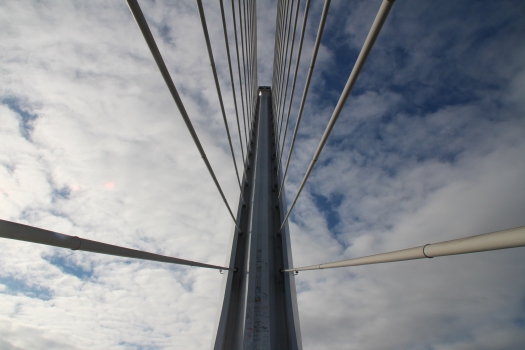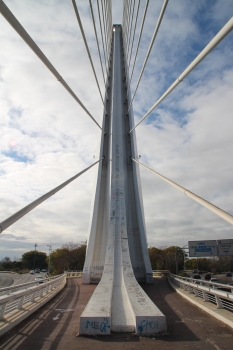General Information
| Name in local language: | Puente del Alamillo |
|---|---|
| Beginning of works: | 1987 |
| Completion: | 1992 |
| Status: | in use |
Project Type
| Structure: |
Cable-stayed bridge without backstays |
|---|---|
| Function / usage: |
Road bridge |
| Structure: |
Cable-stayed bridge with harp system |
| Material: |
Steel-reinforced concrete composite bridge |
| Secondary structure(s): |
Structurae Plus/Pro - Subscribe Now! |
| Material: |
Structurae Plus/Pro - Subscribe Now! |
| Secondary structure(s): |
Structurae Plus/Pro - Subscribe Now! |
Location
| Location: |
Sevilla, Sevilla, Andalusia, Spain |
|---|---|
| Crosses: |
|
| Part of: | |
| See also: |
La Cartuja Viaduct (1992)
|
| Coordinates: | 37° 24' 48" N 5° 59' 26" W |
Technical Information
Dimensions
| main span | 200 m | |
| total length | 250 m | |
| number of cables | 26 | |
| pylon | height | 142 m |
| angle of inclination | 58° |
Materials
| cables |
steel
|
|---|---|
| pylon |
reinforced concrete
|
| deck |
composite steel-reinforced concrete
|
Excerpt from Wikipedia
The Alamillo Bridge (Spanish:Puente del Alamillo) is a structure in Seville, Andalucia (Spain), which spans the Canal de Alfonso XIII, allowing access to La Cartuja, a peninsula between the canal and the Guadalquivir River. The bridge was constructed as part of infrastructure improvements for Expo 92, which was held on large banana farms on the island. Construction of the bridge began in 1989 and was completed in 1992 from a design by Santiago Calatrava.
Design
The static concept of the bridge can be traced back to the 1986 sculpture by Calatrava entitled 'Running Torso', in which inclined stacked marble cubes are balanced by a tensioned wire. The Alamillo Bridge consists of a single straight steel-shell tower, infilled with reinforced concrete and inclined backward, counterbalancing a 200 m span with thirteen pairs of cables. Since the weight of the tower is made to be sufficient to counter-balance the deck, back stays are thus not required, effectively substituting the weight of an inclined tower for one set of stay cables. In this way, a new type of cantilever spar cable-stayed bridge was conceived in 1987.
The original intent was to build two symmetrical bridges on either side of the island, but in the end the Alamillo's singular asymmetric design has proved most striking.
The bridge deck consists of an hexagonal steel-box-beam spine to which the stay cables are attached. Side steel wings cantilevered off the hexagonal spine support the traffic decks, three lanes on each side. The top of the hexagonal spine, elevated 1.6 meters (5 feet) above the road level, serves as an elevated footway and cycle lane in between the traffic lanes.
This bridge represented the soaring aspirations of the city of Seville in preparation for Expo '92, and is visible from the top of La Giralda, the former minaret which is the sentimental roof of the city, linking Seville's past and present. Similar to the Brooklyn Bridge, there is an elevated walkway for pedestrians. In addition to the elevated walkway, the Alamillo Bridge features a lookout at the top of the inclined tower, accessible by an stairway enclosed within the tower.
The Alamillo Bridge is the first cable-stayed bridge that is balanced solely through the weight of the massive tower, not requiring any type of back stays or anchorage. There are 54 steel piles under the bridge, acting passively under the tower. Calatrava's Sundial Bridge in Redding, California (2004), the Mesoghion Avenue Footbridge in Athens and Chords Bridge in Jerusalem (2008) are similar in design to the Alamillo Bridge.
Critique
While the Alamillo Bridge is dramatic and widely acclaimed aesthetically, an analysis of ist structural engineering show that it has an inefficient dynamic structural form because of the lack of backstays or anchorage to provide a restoring force under changing loads. One indication of this is the extreme weight of the pylon member needed in the Alamillo Bridge compared with other cable-stayed bridges such as the Erasmus Bridge in Rotterdam, which has a backward-inclined pylon and backstays. The total mass of the pylon of the Alamillo Bridge is over 10 times the pylon mass of the Erasmus Bridge, which has even a longer span than the Alamillo.
Text imported from Wikipedia article "Alamillo Bridge" and modified on June 3, 2020 according to the CC-BY-SA 4.0 International license.
Participants
-
Santiago Calatrava SA
- Santiago Calatrava (designer)
Relevant Web Sites
Relevant Publications
- (1997): The Alamillo cable-stayed bridge: special issues faced in the analysis and construction. In: Proceedings of the Institution of Civil Engineers - Structures and Buildings, v. 122, n. 4 (November 1997), pp. 432-450.
- (2008): Amortiguadores puente del Alamillo e instrumentación de tirantes. Presented at: IV Congreso de la Asociación Científico-Tecnica del Hormigón Estructural - Congreso Internacional de Estructuras, Valencia, 24-27.11.2008.
- (1997): L'art de l'ingénieur. constructeur, entrepeneur, inventeur. Éditions du Centre Georges Pompidou, Paris (France), pp. 47-48.
- (2002): Bridges that Changed the World. Prestel, Munich (Germany), pp. 106-107.
- (2002): Brücken, die die Welt verbinden. Prestel, Munich (Germany), pp. 106-107.
- About this
data sheet - Structure-ID
20000002 - Published on:
28/10/1998 - Last updated on:
06/03/2018

